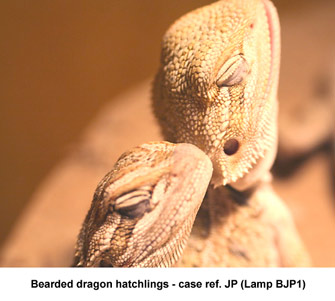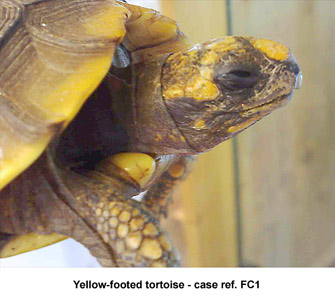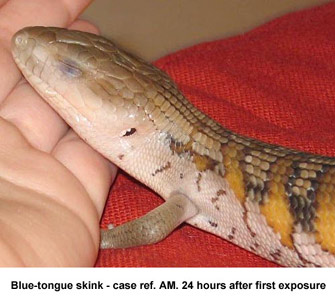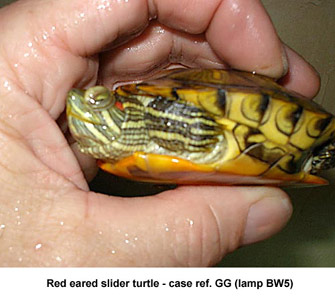|
Introduction
| Please
note: This report was
written in the second half of 2007, with updates made
regularly until April 2008. We continue to hear of very
small numbers of cases but fortunately, owing to the
positive efforts of most of the companies whose products
were involved, lamps causing these problems are being
steadily replaced by re-formulated products which don't
emit abnormally short-wavelength UVB radiation. (See
later for an explanation of this.) However there
are still small numbers of "old stock" of
certain products on sale in some areas, and there is
always the possibility that a new untested product may
be introduced and found to cause problems. This section
of the website will shortly be revised to bring it fully
up to date; but this report is still valid today - September
2009. |
A
small but increasing number of cases have been reported
of pet reptiles which have developed the symptoms of photo-kerato-conjunctivitis,
which is usually the result of abnormally high exposure
to ultraviolet radiation. Typical symptoms included a refusal
of the animals to open the eyes, lethargy and inappetance;
many also stopped basking. More severely affected animals
developed swollen eyelids,
and a small number developed lesions resembling burns and
exfoliation of the skin of the eyelids. (More
information: "What
is photo-kerato-conjunctivitis?")
Most
of the affected reptiles recovered within 2 – 14 days once
the lamps were removed, but we have now heard of five animals
- three chameleons and two hatchling bearded dragons - which
died before the cause of the problem was recognised. One
of the chameleons which died also suffered severe skin damage,
also believed to be caused by the lamp.
In
previous years, we have heard of a few isolated cases; usually
these have been following the positioning of an especially
high-UVB lamp (such as certain types of mercury vapour lamp)
particularly close to a species that does not normally bask
in sunlight. However, there seems to have been a sudden
increase in the number of cases reported, over the last
12 months, almost entirely associated with the use of specific
brands of new “high output” UVB fluorescent
lamps. Moreover, species which are known to bask
in full sunlight, such as bearded dragons and red-eared-slider
turtles, have been affected.
Photographs
of some of the affected animals (from our case studies)
are shown in figs. 1-4. The painful condition leads to a
refusal to open the eyes, and in some cases, very swollen
eyelids.
The
investigation
We
began a serious investigation of these reports in April
2007 following an alert from one of the organisers of a
popular hobbyists’ website forum in the USA, www.redearslider.com,
where members had become very concerned following a spate
of problems in turtles across the USA.
We
have now documented 40 individual cases, occurring since
September 2006, affecting 16 turtles, 3 tortoises and 21
lizards in the USA and in Europe, affected by ZooMed
Reptisun 10.0 Compact Lamps and (more rarely)
5.0 Compact Lamps.
We are aware of one incident reported previously, associated
with a Big Apple Herpetological
Mystic Lamp.
At the beginning of September 2007, we first become aware
of reptiles being affected by excessive UVB radiation from
lamps from the R-Zilla Desert 50
series lamps; we now know of five incidents involving
at least another 40 animals (one case involves a large number
of bearded dragons owned by a breeder).
We
have therefore thoroughly tested samples of the new-style
ZooMed Reptisun compact lamps and Big Apple Herpetological
Mystic lamps, and two lamps from the new R-Zilla Desert
50 Series. We have compared their output with similar UVB
fluorescent lamps and tubes of other brands which, as far
as we are aware, have not caused this problem.
The
full reports on the lamps
we have tested have now been completed. The case
histories relevant to the ZooMed compact lamps
are complete; we are still gathering data regarding the
cases relevant to the R-Zilla lamps.
Each company has been
sent a very detailed report with all the lamp test results
and case histories relating to their products. We
earnestly hope and believe that all will respond swiftly
and positively to our discoveries. We
have already received encouraging responses, as each company
begins to address the problem, and
we will be publishing their information as soon as we receive
it.
(Latest
update
- 23rd September 2009)
The
report on the ZooMed lamps was co-authored by Frances Baines
in the UK (FB) and exotic specialist veterinary surgeon
Michele Buono in Italy (MB), who has contributed a number
of case reports. The reports on the R-Zilla and Big Apple
Herpetological lamps are by Frances Baines. What is published
here on UVGuideUK is a condensed report, combining the highlights
of all the work done so far on all three brands. Unfortunately,
the very nature of this work means that it is going to be
"heavy reading", but the reason for the problem
is not obvious - which is presumably why it has occurred
in the first place.
The report is divided into four sections:
- Case
histories. We have summarised all the information
we have received to date, in table form. We have also
been able to write much more detailed case histories for
twelve incidents involving use of a Reptisun 10.0 Compact
Lamp (seven personally examined by MB and five reported
in detail by the owners themselves, to FB) and one involving
the use of a R-Zilla Desert 50 series T8 linear tube,
also reported to FB by the owner.
We are publishing these in full, here
on UV Guide UK.
- Lamp
test results. The full test results are
not published here in full, because of the large amount
of material. (The report to ZooMed, for example, is 60
pages long.) We have summarised the results, using graphs
and charts wherever possible. This covers all the essential
details. To read these highlights, click here.
However, we are willing to email the full reports (as
large pdf. files) to individual enquirers on request.
Please email admin, stating clearly which report you require.
(Only one will be sent per email reply, because of their
file size - up to 1.5MB)
- Discussion
about the "phototherapy" phosphor we
have found in the lamps which have caused problems. Read
here
why we are concerned that its inclusion in reptile lamps
may be of concern.
- Summary,
Recommendations and Company Responses. These are
available here.
The Summary sets out our conclusions as to why these lamps,
in particular, have caused problems. Our Recommendations
include suggestions for reducing the likelihood of these
lamps producing photo-kerato-conjunctivitis if they are
used in reptile husbandry, but our main recommendation
is this:
The
production of non-solar UVB and high levels of low-wavelength
solar UVB by the "phototherapy" phosphor used in these
lamps may be a cause for particular concern.
Further studies are needed to ascertain whether long-term
exposure to these wavelengths, at any intensity,
is in any way detrimental to reptile health.
Until such studies have been
carried out, and the risks to reptile health properly
assessed, we recommend that alternative phosphors
be used in these lamps.
|
We
are very pleased to be in contact with the companies selling
the lamps featured in this report. As they keep us informed
of their progress in addressing these issues, we will
keep you informed by publishing their responses in this
section.
(Latest
update
- 23rd September 2009)
- References.
Throughout these pages, we have provided links to a detailed
reference list of scientific papers and other relevant
material.
Continue
to: Case
histories
Return to: beginning
of report
|





















